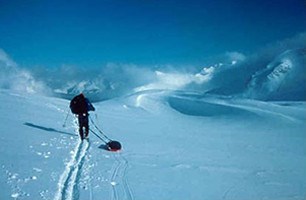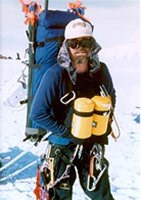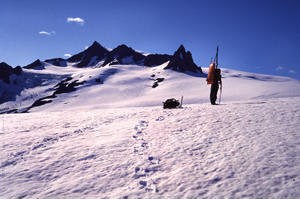
NPS Photo The Harding Icefield offers excellent mountaineering possibilities. Parties wishing to explore the icefield should be well versed in glacier travel and crevasse rescue techniques and should be experienced skiers. However, people can also travel on the icefield with snowshoes. Travelers should rope together whenever moving on the icefield as buried crevasses can be encountered anywhere. Access 
NPS Photo The most popular routes are from Tustemena Glacier to Exit Glacier and from Chernof Glacier (via the Fox River on Kachemak Bay) to Exit Glacier. Exit Glacier is the ideal ‘exit’ since it is the one access point where you don’t have to rely on meeting a boat or a plane. There is no way to predict exactly how long a traverse will take, so it is easier to end the trip where you don’t have to have a pre-arranged pick up date/time. Successful traverses have taken anywhere from six days to two weeks, but many parties have been turned back by the weather. Storms from the Gulf of Alaska can sweep in at any time of year, bringing winds in excess of 100 miles per hour. Anyone attempting to travel on or transverse the icefield must be prepared for the possibility of being pinned down by winds and whiteout for days at a time. 
NPS / Peter Fitzmaurice Camping Food Storage Human Waste Disposal
Don't Forget These Essentials...
Those lucky enough to have good weather can experience an awesome glimpse back into the ice age, when entire continents were dominated by glaciers. Isolated nunataks jut up from the vast white expanse like dark islands in a smooth sea, begging to be explored. The view from the summit of one of these jagged peaks is indescribably beautiful and eerie. Excerpted and adapted from "The Complete Guide to Kenai Fjords" copyright Greatland Graphics www.alaskacalendars.com |
Last updated: April 14, 2015
